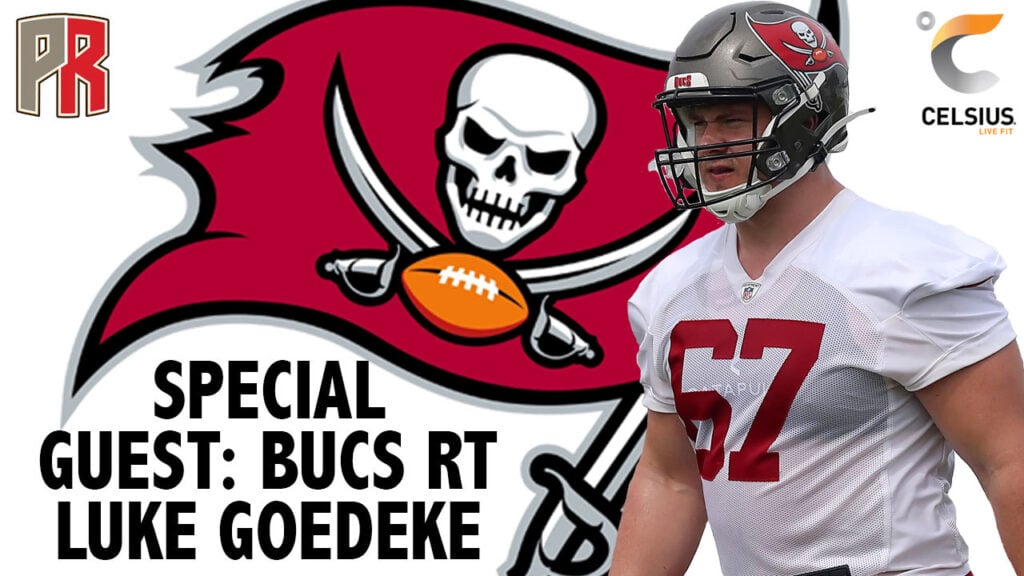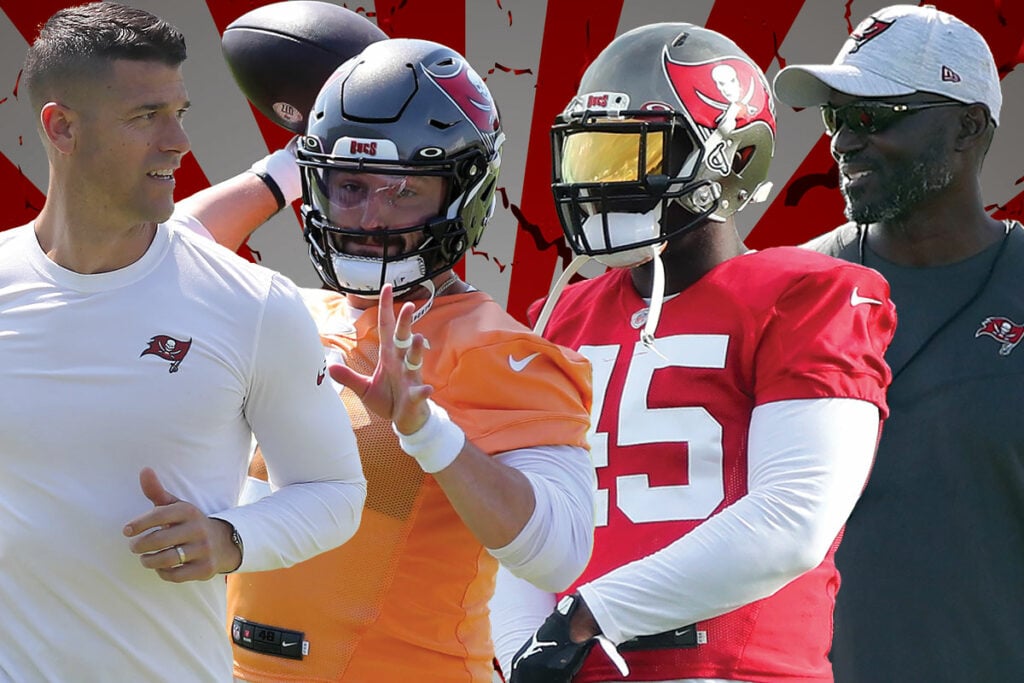In an ongoing summer series, Pewter Report looks at and ranks each position group in the NFC South. So far, we’ve chronicled and ranked the NFC South quarterbacks, running backs and wide receivers. Now it’s on to the NFC South’s tight ends.
Much like the wide receivers, the NFC South tight end room runs a wide gamut of the NFL overall. There is one room that is in the running for one of the best in the entire league and one room that would be in the running for one of the worst/least proven. For this group I will be looking at public grading metrics while also considering traditional statistics like catches and yards as well as more advanced metrics like yards per route run, average separation, catch rate and contested catch rate. I will be evaluating each group based on their projected top three tight ends.
Atlanta Falcons
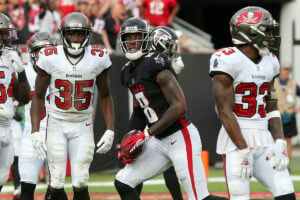
Falcons TE Kyle Pitts – Photo by: Cliff Welch/PR
This is the second group where the Falcons show up in the top spot thus far, joining their running back room. The offense as a whole for the Falcons is probably underrated and has the best chance to be the highest-scoring offense in the division despite having the biggest question mark at quarterback.
Leading things off for this group is “The Unicorn.” Kyle Pitts may be better grouped with the wide receivers. And had I done that, it would have lifted Atlanta’s fourth-ranked receiver room. But he is listed as a tight end and did spend over a quarter of his snaps in-line last year (which was a 4% improvement over his rookie campaign) so we will keep him there.
After a 1,000-yard debut campaign where he averaged over 15 yards per catch, Pitts suffered a down year in 2022 due to injury and reduced quarterback play. The results were 28 catches for 356 yards and two touchdowns. However, since entering the league he has averaged almost two yards per route run with an average depth of target of 12.0 and a drop rate of just 4.0%. Pitts is one of just a handful of tight ends in the league who has proven they can successfully operate as the focal point of a passing game.
Behind Pitts, the Falcons picked up buy-low candidate Jonnu Smith. Just two years after signing one of the most lucrative contracts in history for a tight end, Smith was cut by the Patriots after they struggled to use him to his full potential. One person who knows how to get the most out of Smith is Falcons head coach Arthur Smith. During coach Smith’s tenure as offensive coordinator of the Tennessee Titans in 2019 and 2020, player Smith had the two best years of his career.
The athletic tight end posted Pro Football Focus grades of 72.0 and 75.2 while accumulating 76 catches for 887 yards and 11 touchdowns. Furthermore, Smith figures to be the perfect complement to Pitts, operating more in-line and on short-to-intermediate routes, allowing Pitts to work as a “move” tight end, in the slot and out wide.
Parker Hesse figures to play third fiddle in the Falcons offense. Hesse isn’t much of a receiving threat, garnering just 17 targets over the past two years. However, he is an extremely effective blocker in 12 and 13 personnel. Hesse has earned pass blocking grades of 77.4 and 70.9 and run blocking grades of 72.5 and 61.2 from PFF over the same time period. Hesse will get some snaps and add to the Falcons dangerous run game.
With a proven alpha, a reliable pass catching No. 2 who has shown success in this offense and a solid blocking No. 3, the Falcons have the best tight end group in the NFC South.
New Orleans Saints

Saints TE Juwan Johnson – Photo by: USA Today
While not quite as good as the Falcons, the Saints sport one of the best tight end rooms in the NFC when you consider depth. At the top of the list is the criminally underrated Juwan Johnson. The undrafted free agent out of Oregon spent his second year in the league quietly becoming one of the better players in the NFC at tight end.
While emerging as the Saints’ No. 1 tight end, he caught 42 of 61 passes for 508 yards and seven touchdowns. Johnson ranked 17th in the league in yards per route run and seventh in average depth of target. And Johnson’s 1.1 yards after catch above expected ranked ninth among qualified tight ends per Next Gen Stats.
Behind Johnson is the reliable presence of Foster Moreau. Over his first four years in the league Moreau has proven to be a reliable No. 2 behind Darren Waller while averaging 23 catches, 277 yards and three touchdowns per season. Moreau has produced PFF grades between 58.8 and 70.8 showing he can be a high-end No. 2 who can spot start when need be.
The final piece to the Saints tight end puzzle is gadget player extraordinaire Taysom Hill. Hill is quite possibly one of, if not the, most unique players in the league. And while he will most likely never be a full time starting anything (quarterback or tight end), it does not change the fact that he is a big-play creator who works out of the tight end room.
With 42 combined rushing, receiving and passing touchdowns for his career, Hill must be accounted for every time he sets foot on the field. What he lacks in play-to-play consistency he more than makes up for in big play threat. Hill’s uniqueness sets him apart from any other tight end in the NFC South.
With a blend of ascending talent, reliable secondary option and dangerous weapon, the Saints have the second-best tight end room in the NFC South.
Carolina Panthers
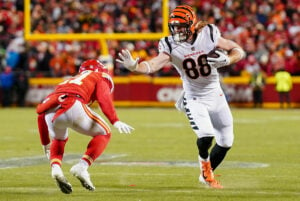
Panthers TE Hayden Hurst – Photo by: USA Today
The Panthers’ tight end room ranks third in the NFC South due to its consistency and lack of ceiling. Between Hayden Hurst, Ian Thomas and Tommy Tremble the Panthers can count on unremarkable NFL level play.
Hurst experienced a bit of a renaissance in 2022 playing on a one-year flyer with the Bengals. Tasked with operating as a safety blanket for superstar quarterback Joe Burrow behind elite playmakers Ja’Marr Chase, Tee Higgins and Tyler Boyd, Hurst enjoyed his best season since being traded from Baltimore to Atlanta following the 2019 season. He secured 80% of his targets for 52 catches operating largely in an afterthought role.
However, those 52 catches yielded just 414 yards and two touchdowns. Hurst’s average depth of target fell to a career-low 5.3 while his yards after catch per reception and yards per route run were both below his career average. At this point in his career Hurst is far from the athlete that helped him become a first-round draft pick. However, he is a reliable pair of hands who can find ways to get open underneath. For a rookie quarterback that can be a lifesaver.
Thomas received a significant contract extension from the Panthers just a year ago. Thomas rewarded the team with just 21 catches, 197 yards and no touchdowns. That contract was signed with an old regime and the current one has no obligation to keep him on for any longer than it is financially prudent to do so. Despite his large frame and impressive athleticism Thomas has failed to cement himself as an NFL starter. His best campaign from a grading standpoint was 2018 when he posted a PFF grade of 53.3. Thomas is a solid pass blocker and decent run blocker, but just does not offer much as a receiving threat.
Tremble similarly has not lived up to the potential that made him a third-round pick in 2021. The small, but athletic tight end has failed to secure even 65% of his targets in his two seasons despite an average depth of target of just 8.6. He has struggled to get open or make difficult contested catches. Perhaps new head coach Frank Reich can get more out of the young pass catcher, but I’m not optimistic.
The Panthers most likely won’t be devoid of capable tight end play in 2023, but they rank third in the NFC South among tight end groups because they are the least likely to have high end play from this group as well.
Tampa Bay Bucs
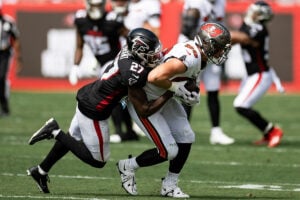
Bucs TE Cade Otton – Photo by: Cliff Welch/PR
The Bucs have the youngest tight end group in the NFL, let alone the NFC South. Cade Otton is technically the veteran of the group by virtue of being drafted a few hours before Ko Kieft. Otton is coming off of a solid rookie campaign where he established himself as the more reliable starting option down the stretch. Otton ended the season with a 56.6 PFF grade.
But there are still serious questions on whether he can be anything more than a replacement-level starter in the NFL. And when he is by far the best option and there is little competition pushing him for the starting role, you have easily the worst tight end group in the NFC South.
With youth comes potential. And Otton provides plenty of potential. You could see it in spurts last year as he made several clutch catches late in games. These were often big plays on long seam routes, or game winning scores, as was the case against New Orleans on Monday Night Football.
Otton has shown some promise as a receiver but will need to show he can play a more consistent role throughout the game. The new system offensive coordinator Dave Canales is implementing isn’t just quarterback-friendly but is tight end-friendly as well and should give Otton those opportunities. But while there is potential Otton will need to improve in several facets of his game. He ranked 33rd in catch rate (66.7%), 24th in yards after catch (4.5) and 36th in average depth of target.
Rookie Payne Durham figures to be the likely No. 2 in this room. Durham is a more accomplished college pass catcher than Kieft and is known as a solid blocker to give him a more well-rounded skill set. The Bucs are hopeful that Durham’s penchant for making tough contested catches and his penchant for being a goal line threat translate to the NFL level, giving them a perfect complement for Otton’s yards after catch ability.
Finally, Kieft should slot in as the blocking H-back/third tight end that he served so well in last year. He was solid, if unspectacular as a blocker in both the run and pass game, while proving to be a pleasant surprise as a pass catcher. Kieft hauled in seven of his ten targets for 80 yards and a touchdown. Kieft may see more opportunities in the Bucs revamped offense this year.
The Bucs room is probably the hardest to peg down and projects to have the most variance in outcomes. Otton could take a big leap, Kieft could shine in the new offense and Durham could live up to his tough catch reputation. Or all three could be the victims of growing pains due to their youth and inexperience without a seasoned veteran to help them develop. Ultimately, while the most reasonable place to put them within the NFC South is fourth, I could easily see them jumping a spot…or maybe even two by year’s end.
Final Thoughts
Overall, the NFC South sports a wide variety of tight end rooms. From the uber-talented, to the diverse, to the solid but uninspiring, to the young and unproven. It makes for a very interesting evaluation. But ultimately the hierarchy of this position group within the NFC South is fairly two-tiered with the Falcons and Saints holding a clear advantage over the Panthers and Bucs.
Josh Queipo joined the Pewter Report team in 2022, specializing in salary cap analysis and film study. In addition to his official role with the website and podcast, he has an unofficial role as the Pewter Report team’s beaming light of positivity and jokes. A staunch proponent of the forward pass, he is a father to two amazing children and loves sushi, brisket, steak and bacon, though the order changes depending on the day. He graduated from the University of South Florida in 2008 with a degree in finance.


